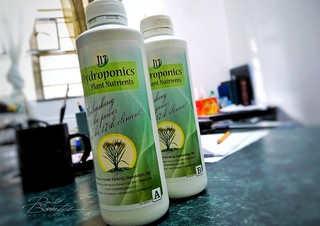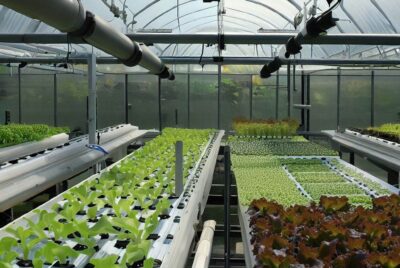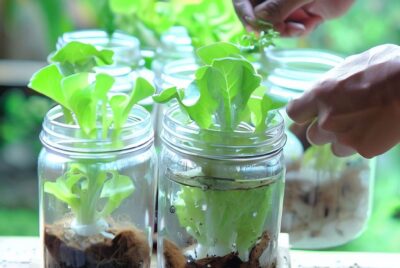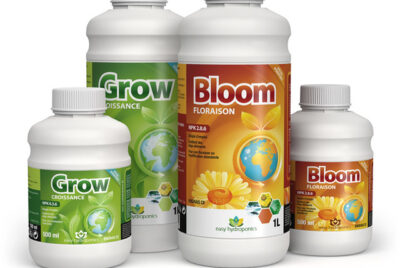Hydroponic Fertilizer: Guide
*We may earn a commission for purchases made using our links. Please see our disclosure to learn more.
When planning a hydroponic garden, you must understood the crucial role that hydroponic fertilizer plays in ensuring robust plant growth and bountiful harvests. In this article, I will guide you through the world of hydroponic fertilizers, offering valuable insights and practical suggestions to help you make informed decisions about nourishing your hydroponic plants.
Understanding Hydroponic Fertilizer to Maximize Plant Growth
Definition and Purpose
Hydroponic fertilizer is a specialized nutrient solution designed to provide plants with the essential elements they need for healthy growth in a soilless environment. Unlike traditional soil-based gardening, hydroponic systems rely on these fertilizers to deliver precise amounts of nutrients directly to the plant roots.
The primary purpose of hydroponic fertilizer is to ensure that plants receive all the necessary macro and micronutrients required for optimal growth. These nutrients include nitrogen (N), phosphorus (P), potassium (K), calcium (Ca), magnesium (Mg), and various trace elements like iron (Fe), manganese (Mn), and zinc (Zn). By providing these nutrients in balanced ratios, hydroponic fertilizers support vigorous plant development, promote higher yields, and minimize the risk of nutrient deficiencies.
Nutrient Requirements
Understanding the specific nutrient requirements of plants in hydroponic systems is vital for successful cultivation. While the exact nutrient needs may vary depending on the plant species and growth stage, certain elements are universally essential.
Macronutrients, such as nitrogen, phosphorus, and potassium, play critical roles in plant metabolism, energy production, and structural development. These primary nutrients are required in larger quantities compared to micronutrients. Micronutrients, on the other hand, are needed in smaller amounts but are equally important for enzyme activity, chlorophyll synthesis, and overall plant health.
To ensure optimal plant nutrition, hydroponic fertilizers are formulated to deliver these essential nutrients in a readily available form that can be easily absorbed by the plants’ roots.
Types of Hydroponic Fertilizers
Hydroponic fertilizers come in various forms, each with its own advantages and considerations. Understanding these options can help you choose the most suitable fertilizer for your hydroponic setup.
1. Liquid Hydroponic Fertilizers:
Liquid fertilizers are highly popular among hydroponic gardeners due to their ease of use and rapid nutrient absorption. They are typically sold as concentrated solutions that can be diluted with water to achieve the desired nutrient strength. Liquid fertilizers offer precise control over nutrient levels, making it easier to fine-tune the nutrient solution for different plant varieties and growth stages.
2. Powdered Hydroponic Fertilizers:
Powdered fertilizers, also known as dry or solid fertilizers, come in the form of granules or powders that are dissolved in water before application. They often contain a blend of nutrients in a balanced ratio, providing a convenient and cost-effective option for hydroponic gardeners. Powdered fertilizers are known for their long shelf life and easy storage, making them a popular choice for both beginners and experienced growers.
3. Organic Hydroponic Fertilizers:
For those who prefer organic gardening practices, organic hydroponic fertilizers offer a natural and sustainable alternative. These fertilizers are derived from organic sources, such as composted materials, seaweed extracts, or fish emulsions. Organic hydroponic fertilizers provide essential nutrients while also enriching the hydroponic system with beneficial microorganisms and organic matter. They promote soil health, enhance nutrient availability, and contribute to environmentally friendly gardening practices.
Now that we have explored the basics of hydroponic fertilizer, let’s delve deeper into the process of selecting the right fertilizer for your hydroponic system and customizing nutrient solutions to meet your plants’ specific needs.
Choosing the Right Hydroponic Fertilizer
Factors to Consider
Several factors should be taken into account when choosing a hydroponic fertilizer to ensure optimal plant growth and productivity.
1. pH Requirements:
The pH level of the nutrient solution directly affects nutrient availability and uptake by plants. Different plants have specific pH preferences, so it is crucial to select a hydroponic fertilizer that matches your desired pH range. Most hydroponic crops thrive in slightly acidic to neutral pH conditions, typically ranging from 5.5 to 6.5.
2. Nutrient Ratios:
Plants require different nutrient ratios during different growth stages. For example, during the vegetative phase, plants need higher nitrogen levels to support leaf and stem development, while the flowering phase requires increased phosphorus and potassium for robust flower and fruit production. Therefore, it is essential to select a hydroponic fertilizer that provides the appropriate nutrient ratios for each growth stage.
Nutrient Solutions
In hydroponics, nutrient solutions act as the primary source of plant nutrition. These solutions consist of water and a carefully balanced blend of hydroponic fertilizers, delivering the necessary nutrients directly to the plant roots.
There are two main types of nutrient solutions commonly used in hydroponics:
- Pre-mixed Nutrient Solutions: Pre-mixed nutrient solutions are commercially available formulations that come in concentrated form. They are designed to provide a balanced nutrient profile for general hydroponic applications. These solutions are convenient and easy to use, especially for beginners who may not have experience with customizing nutrient solutions.
- Customized Nutrient Solutions: Advanced hydroponic gardeners often prefer to create their own nutrient solutions, allowing for precise control over nutrient levels and ratios. This approach allows growers to tailor the nutrient solution to the specific requirements of different plant species and growth stages. Customization involves measuring and mixing individual hydroponic fertilizers according to specific recipes or recommendations provided by experts or fertilizer manufacturers.
Customizing Nutrient Solutions
To maximize plant growth and address specific nutritional needs, customizing nutrient solutions is often necessary. By adjusting nutrient concentrations based on plant species, growth stage, and environmental conditions, you can optimize nutrient uptake and minimize the risk of nutrient imbalances.
During the early vegetative stage, plants generally require higher nitrogen levels to support vigorous leaf growth. As they transition to the flowering or fruiting stage, the nutrient solution should be adjusted to provide higher phosphorus and potassium levels to promote flower and fruit development.
To customize your nutrient solution effectively, it is essential to monitor the pH and electrical conductivity (EC) of the solution regularly. pH adjustments can be made using pH up or pH down solutions to maintain the desired pH range for your plants. The EC indicates the nutrient concentration in the solution and can be adjusted by adding more or less hydroponic fertilizer.
By understanding the specific needs of your plants and adjusting the nutrient solution accordingly, you can achieve optimal growth and maximize the potential of your hydroponic system.
In the next section, we will explore the proper application techniques and dosages of hydroponic fertilizers to ensure efficient nutrient uptake and avoid common pitfalls.
Application and Dosage
To maximize the effectiveness of hydroponic fertilizers and promote healthy plant growth, proper application techniques and dosage are essential. Here’s what you need to know:
Proper Application Techniques
- Root Zone Application: In hydroponic systems, the nutrient solution is typically delivered directly to the plant roots. Common methods include drip irrigation, nutrient film technique (NFT), or flood and drain systems. Ensure that the nutrient solution reaches the root zone effectively and evenly to provide consistent nutrition to all plants.
- Foliar Feeding: Occasionally, foliar feeding can be beneficial, especially for providing micronutrients or correcting deficiencies. Dilute the hydroponic fertilizer in water and spray it onto the leaves, allowing for absorption through the foliage. However, foliar feeding should not replace root zone application as the primary method of nutrient delivery.
- Maintaining Proper pH Levels: Regularly monitor and adjust the pH of your nutrient solution to ensure optimal nutrient availability. Use pH testing kits or digital pH meters to measure the pH level and make necessary adjustments using pH up or pH down solutions. Aim for a pH range that is suitable for your specific plant species and growth stage.
Dosage Recommendations
- General Guidelines: Hydroponic fertilizers typically come with dosage recommendations provided by the manufacturer. These guidelines serve as a starting point for nutrient application. Follow the instructions closely, but also consider the unique needs of your plants and the specific conditions in your hydroponic system.
- Monitor and Adjust: It’s crucial to monitor your plants for signs of nutrient deficiencies or toxicities. Adjust the dosage of your hydroponic fertilizer accordingly to maintain a balanced nutrient supply. Remember that nutrient requirements may change as plants progress through different growth stages.
- Avoid Overfeeding: Overfeeding can lead to nutrient imbalances or toxicity, which can harm plant health. Start with lower nutrient concentrations and gradually increase as needed. Monitor plant growth and adjust nutrient levels accordingly to prevent excessive nutrient buildup.
By implementing proper application techniques and adhering to dosage recommendations, you can ensure that your hydroponic plants receive the right amount of nutrients for healthy and robust growth.
Troubleshooting Common Issues
Despite your best efforts, nutrient imbalances or pH fluctuations may occur in hydroponic systems. Here are some common issues and troubleshooting tips to help you address them:
Nutrient Imbalances
- Identifying Nutrient Deficiencies: Keep a close eye on your plants for any signs of nutrient deficiencies, such as yellowing leaves, stunted growth, or leaf discoloration. Refer to nutrient deficiency charts or guides to identify the specific nutrient causing the issue.
- Adjusting Nutrient Levels: If a deficiency is detected, adjust the nutrient solution by increasing the concentration of the deficient nutrient or using a specific hydroponic fertilizer designed to address the deficiency. Be careful not to overcompensate, as excessive nutrient levels can cause other imbalances.
- Flushing and Replenishing: If nutrient imbalances persist, consider flushing your hydroponic system with clean, pH-balanced water to remove excess salts and reset the nutrient profile. After flushing, replenish the nutrient solution with a well-balanced hydroponic fertilizer.
pH Fluctuations
- Regular pH Monitoring: Consistently monitor the pH of your nutrient solution using pH testing kits or digital pH meters. Check pH levels daily or at least every few days to catch any fluctuations promptly.
- Adjusting pH Levels: If the pH deviates from the desired range, use pH up or pH down solutions to make the necessary adjustments. Follow the manufacturer’s instructions for proper dosage and gradual pH corrections.
- Maintaining pH Stability: To promote pH stability, consider using buffering agents or pH stabilizers designed for hydroponic systems. These additives help maintain the pH within the desired range, even in the presence of fluctuations.
By proactively troubleshooting nutrient imbalances and pH fluctuations, you can ensure a stable and optimal growing environment for your hydroponic plants.
Sustainable Hydroponic Fertilizer Practices
When starting a hydroponic garden system, you can contribute to sustainable gardening practices by implementing the following strategies:
Recycling Nutrient Solutions
- Monitoring and Adjusting: Regularly monitor the nutrient levels in your hydroponic system. Adjust the nutrient solution by replenishing depleted nutrients rather than discarding the entire solution. This reduces waste and promotes resource efficiency.
- Drain-to-Waste Systems: Consider using drain-to-waste systems where excess nutrient solution is discarded after each irrigation cycle. This allows for precise nutrient control and minimizes the risk of nutrient imbalances.
- Reusing Nutrient Solutions: Some hydroponic gardeners choose to reuse nutrient solutions for multiple crop cycles. Before reusing, thoroughly test and adjust the nutrient solution to ensure optimal nutrient levels and pH.
Hydroponic Organic and Environmentally Friendly Options
- Organic Hydroponic Fertilizers: Explore organic hydroponic fertilizers derived from natural sources, such as compost, worm castings, or fish emulsions. These options provide essential nutrients while minimizing environmental impacts.
- Biological Amendments: Incorporate beneficial microorganisms, such as mycorrhizal fungi or beneficial bacteria, into your hydroponic system. These organisms enhance nutrient availability, improve plant health, and contribute to a balanced ecosystem within your growing environment.
By adopting sustainable practices and making conscious choices about nutrient management, you can cultivate hydroponic gardens that are both productive and environmentally friendly.
Conclusion
Hydroponic fertilizer is the lifeline of your hydroponic garden, providing essential nutrients to fuel robust plant growth and bountiful harvests. By understanding the nutrient requirements of your plants, choosing the right hydroponic fertilizer, customizing nutrient solutions, and troubleshooting common issues, you can create an optimal growing environment for successful hydroponic cultivation.
Remember to monitor your plants closely, adjust nutrient levels based on their specific needs, and maintain proper pH and nutrient balance. Embrace sustainable practices by recycling nutrient solutions and considering organic and environmentally friendly options.
With the right knowledge and practices, you can achieve impressive results in your hydroponic gardening journey and enjoy the benefits of fresh, nutrient-rich produce right at your fingertips.
FAQs (Frequently Asked Questions)
1. Can I use regular fertilizer for hydroponics?
Regular fertilizers designed for soil-based gardening are not suitable for hydroponic systems. Hydroponic fertilizers are specially formulated to provide nutrients directly to the plant roots in a soilless environment.
2. How often should I change the nutrient solution in my hydroponic system?
The frequency of changing the nutrient solution depends on various factors, such as plant growth stage, system size, and nutrient usage. As a general guideline, it is recommended to change the nutrient solution every 1-2 weeks or as needed to maintain optimal nutrient levels and pH stability.
3. Are organic hydroponic fertilizers better than synthetic ones?
The choice between organic and synthetic hydroponic fertilizers depends on personal preferences and specific gardening goals. Organic fertilizers offer a natural and sustainable approach, while synthetic fertilizers provide precise control over nutrient ratios. Both types can be effective when used correctly.
4. Can I mix different brands of hydroponic fertilizers?
Mixing different brands of hydroponic fertilizers is possible, but it is essential to consider nutrient compatibility and ratios. Follow manufacturer recommendations and test nutrient solutions before applying them to your plants to ensure compatibility and avoid imbalances.
5. How can I prevent algae growth in my hydroponic system?
To prevent algae growth in your hydroponic system, keep the nutrient solution away from direct sunlight, maintain proper water temperature, and use opaque or light-blocking materials for system components. Regularly clean and sanitize your system to minimize the presence of algae spores.




